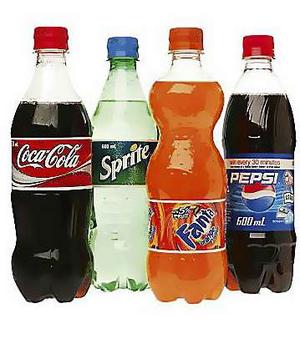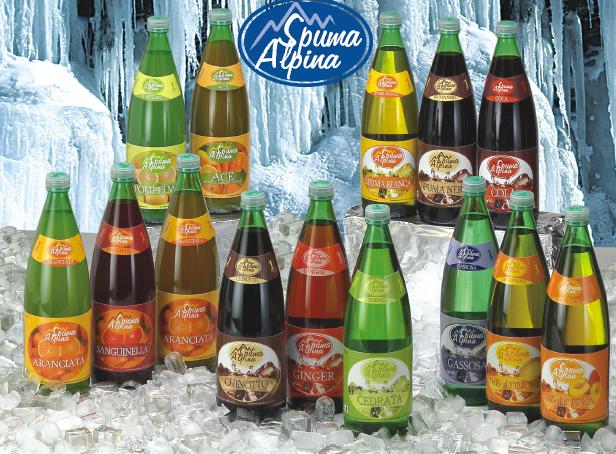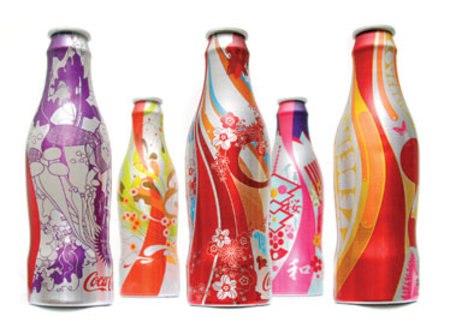
What's Wrong With
Soft Drinks
Over 250 soft drinks are consumed each year for every man woman and child in this country.
Many people drink one or two such drinks a day as a regular habit. It is not uncommon to find people who drink over 100 ounces of cola, pop, or soda every day of their lives.
Soft drinks are addictive. They furnish no nutrition. Many of the soft drinks are a drug and can do damage to the body.
Cola drinks discovered in 1949, contain a solution strong enough to dissolve iron.
Carbonated Water--
Harmless or Harmful?
From 89-93 per cent of a bottle of pop is water. The water is carbonated by putting in carbon dioxide under pressure, causing the bubbles. The carbon dioxide also increases the flavor, making possible a cheaper product. The carbonation, or carbonic acid, in the drink (which makes it "fizz") is decidedly harmful to the eyes and can increase myopia(nearsightedness).
Flavoring--Artificial or
Real?
Your favorite soft drink or fruit drink may come from natural or synthetic sources or a compound of both. Chances are the Florida ripe orange luster gleaming from the bottle in your refrigerator comes from coal tar coloring, though perchance there's actually a portion of real orange juice used. But orange juice or soft drinks, you can probably rely on the presence of an added coloring agent, almost always made from coal tar. The government has certified these coal tars as safe for human consumption, in spite of the fact that other coal tar colorings are known to produce cancer.
Caffeine, A Stimulant
According to the Council on Foods and Nutrition,
cola drinks contain about two-thirds of a grain of caffeine per six ounces of beverage, or about one-third the amount in a cup of coffee. Caffeine is a stimulant, and even the cola advertisers stress that the "life" comes from a "Coke." This "life" that you always get from coffee, always comes from the caffeine. the cola manufacturers argue that since the caffeine content in their drink is only a fraction of that in coffee, it is harmless. But they do not add that children innocently drink bottle after bottle, day after day, thereby far exceeding the caffeine content in a cup or two of coffee.
Caffeine has been found to produce ulcers in animals and in some human beings, and that severe vertigo may also result. This is to say nothing of the common effects of heart and nerve stimulation.
Phosphoric Acid and
Tooth Erosion
As its name suggests, this is a phosphorus compound, and inorganic phosphorus is known to be a toxic element. Its action on tooth enamel has been found to be especially destructive--its powers can be seen by the fact that this acid is used in industrial plants to dissolve rust.
In tests made on rats the phosphoric acid solution caused erosion to the teeth. Their teeth eroded right down to the gum line.
Although we cannot see the enamel of teeth vanishing before our eyes in a matter of hours--because few of us soak our teeth in a phosphoric acid solution--it is easy to understand what can happen to tooth enamel over a short period of time when it is frequently in contact with this acid. The teeth may loose its calcium, which is the most important constituent of tooth enamel.
The American cola beverage has a pH of approximately 2.6. This means it is highly acid. One must understand the chemical term pH, which is like water, has a pH of 7. Numbers less than 7 indicate acidity, and the lower the pH number, the greater the acidity. In other words, according to one investigation, the cola drinks are much more acid and club soda less so.
US House Committee
Investigates
Chemicals In Colas
At a hearing of theUnited States House Committee investigating the use of chemicals in food held in Washington D.C. September 19, 1950, the following information was revealed by Dr.Clive M. McKay, Professor of Nutrition Cornell University, who for three years during World War ll was head of nutrition research for the United Staes Navy: "The popular cola drink is a strange mixture of phosphoric acid, sugar, caffeine, coloring, and flavoring matter. The amount of phosphoric acid is 55%, giving cola drinks an acidity of pH 2.6, or about the same as vinegar. Why doesn't a cola drink then taste like vinegar? Because of the sugar added. But why so much phosphoric acid?
Evidently to keep the water sterile, as no bacteria can live in such acid solutions.
The solution of phosphoric acid in cola drinks is so strong as to cause human teeth to become very soft within 2 days.
In fact it is strong enough to dissolve nails and limestone, and the very substantial amount of caffeine in the cola drinks, without doubt, has a direct bearing on the prevalence of gastric ulcers."
According to Dr.McKay, we would not use cola beverages if most of us were given the real facts. Unfortunately, there is no way for the public to hear about these facts, as information to them is very restricted and it has not even been able to get into the press.It seems that there has been enough research to incriminate carbonated drinks. the contents of soft drinks should be listed on the label, just as the contents of all packaged, canned and bottle foods should be listed on the label.

Sugar--How Much
Nutrition ?
There is so much sugar in a soft drink that heavy drinkers often get an extra pound of white sugar in their diet each day. Blood sugar levels shoot up and sink when soft drinks are consumed. The appetite is dulled, and valuable nutrients are depleted in an attempt to metabolize the sugar in these drinks. When soft drinks are taken with food, the sugar leads to fermentation instead of good digestion.
The concentrated sugar in soft drinks has a decidedly bad effect on blood sugar. When a bottle of pop gives you a momentary "lift" it is because the blood sugar level is raised. But almost immediately the level goes down, brining on a need for another drink--and another. It is easy to see the dangers in this rise and fall, and it is clear that this constantly lowered blood sugar level opens up the road to countless disorders. The harm of drinking sodas falls under three categories:
1. some of the drinks
contain harmful drugs,
2. most of
them have a chemical
reaction strong
enough to injure
cettain parts of the
body, especially the
teeth and
3. their constant use
is almost bound
to have a deleterious
effect of other aspects
of diet. Perhaps their
most
dangerous aspect,
especially for the
health of our children,
is the effect of
carbonated drinks on
dietary habits.
Soft Drinks--Big
Business
There is no way to determine just exactly how many soft drink addicts we have in this country alone, but it is up to the millions. And a large portion of these millions, no doubt are children and young people.
The soft drink business is a $12-billion-a-year industry and it's growing at a rate of about three to four percent a year. One manufacturer, The royal Producer, of the soft drink business, produces colas--colas dripping with caffeine, chemicals, sugar, and phosphoric acid.
In the United States Coke and Pepsi have for years commanded close to two-thirds of the market. Dozens of other less hazardous flavors compete for the rest of the business.
Cola-Cola now controls about 34 percent of the soft drink market, Pepsi Cola holds down24 percent, and Dr, Pepper earns about 7 percent of the market.
Soda Pop And
Osteoporosis?
Soda pop may more than double your risk of breaking your bones. One study links the phosphorus in carbonated beverages with bone fractures in women after age 40.
Soft Drinks--Sweet,
Cheap,
And Detrimental
Nutritionally, soft drinks are low in food value. Their food energy comes solely from refined sugar, every element of nutritional importance, except calories, is zero.
As with all empty foodstuffs, soft drinks may displace nourishing items in the diet. This can lead to malnutrition and obesity.
Soft drink processors may use many different colorings, flavorings, preservatives, antifoaming agents, emulsifiers, and fillers in their beverages. both coal-tar colors and "certified dyes" and "decertified" ones offer unnecessary risks.
The consumer is largely uninformed regarding the ingredients used in soft drinks. The soft drink industry has had a long record of resisting attempts to bring about informative labeling.
In the past few years, soft drink manufacturers have developed "sugarless" drinks. Of course these are artificially sweetened. the sweeteners used are chemial products which have also been implicated as cancer-causing.
Soft drinks are not "soft"--they are HARD on you and your health.
All soft drinks contain a sizable amount of acid, usually phosphoric or citric. Both erode teeth enamel, and impair the appetite as well as the digestive processes by creating excessive acidity in the stomach.
Whether therefore ye eat of drink, or whatsoever ye do, do all to the glory of God.
1 Corinthians 10:31
Katy Chamberlin freedomofhealth.org
